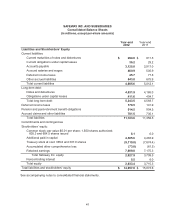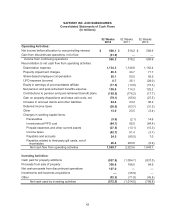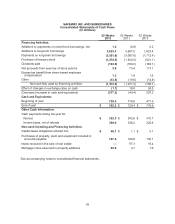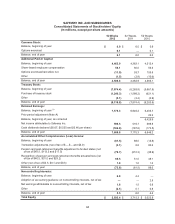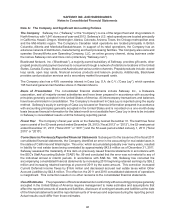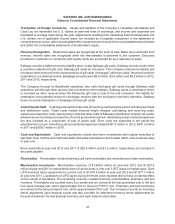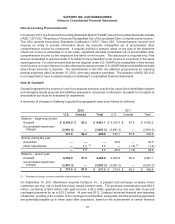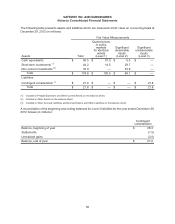Safeway 2012 Annual Report Download - page 60
Download and view the complete annual report
Please find page 60 of the 2012 Safeway annual report below. You can navigate through the pages in the report by either clicking on the pages listed below, or by using the keyword search tool below to find specific information within the annual report.
SAFEWAY INC. AND SUBSIDIARIES
Notes to Consolidated Financial Statements
48
Property and Depreciation Property is stated at cost. Depreciation expense on buildings and equipment
is computed on the straight-line method using the following lives:
Stores and other buildings 7 to 40 years
Fixtures and equipment 3 to 15 years
Safeway capitalizes eligible costs to acquire or develop internal-use software that are incurred during the
application development stage as part of fixtures and equipment. Capitalized costs related to internal-use
software are amortized using the straight-line method over the estimated useful lives of the assets.
Property under capital leases and leasehold improvements is amortized on a straight-line basis over the
shorter of the remaining terms of the leases or the estimated useful lives of the assets.
Employee Benefit Plans The Company recognizes in its statement of financial position an asset for its
employee benefit plan’s overfunded status or a liability for underfunded status. The Company measures
plan assets and obligations that determine the funded status as of fiscal year end. See Note K.
Self-Insurance The Company is primarily self-insured for workers’ compensation, automobile and general
liability costs. The self-insurance liability is determined actuarially, based on claims filed and an estimate of
claims incurred but not yet reported, and is discounted using a risk-free rate of interest. The present value
of such claims was calculated using a discount rate of 0.75% in 2012, 0.75% in 2011 and 2.00% in 2010.
A summary of changes in Safeway’s self-insurance liability is as follows (in millions):
2012 2011 2010
Beginning balance $ 470.9 $ 468.5 $ 453.8
Expense 151.6 151.1 148.3
Claim payments (142.5) (148.6) (134.0)
Currency translation 0.1 (0.1) 0.4
Ending balance 480.1 470.9 468.5
Less current portion (137.4) (129.4) (129.5)
Long-term portion $ 342.7 $ 341.5 $ 339.0
The current portion of the self-insurance liability is included in other accrued liabilities, and the long-term
portion is included in accrued claims and other liabilities in the consolidated balance sheets. The total
undiscounted liability was $496.2 million at year-end 2012 and $485.7 million at year-end 2011.
Deferred Rent
Rent Escalations. The Company recognizes escalating rent provisions on a straight-line basis over the
lease term.
Rent Holidays. Certain of the Company’s operating leases contain rent holidays. For these leases, Safeway
recognizes the related rent expense on a straight-line basis starting at the earlier of the first rent payment
or the date of possession of the leased property. The difference between the amounts charged to expense
and the rent paid is recorded as deferred lease incentives and amortized over the lease term.





